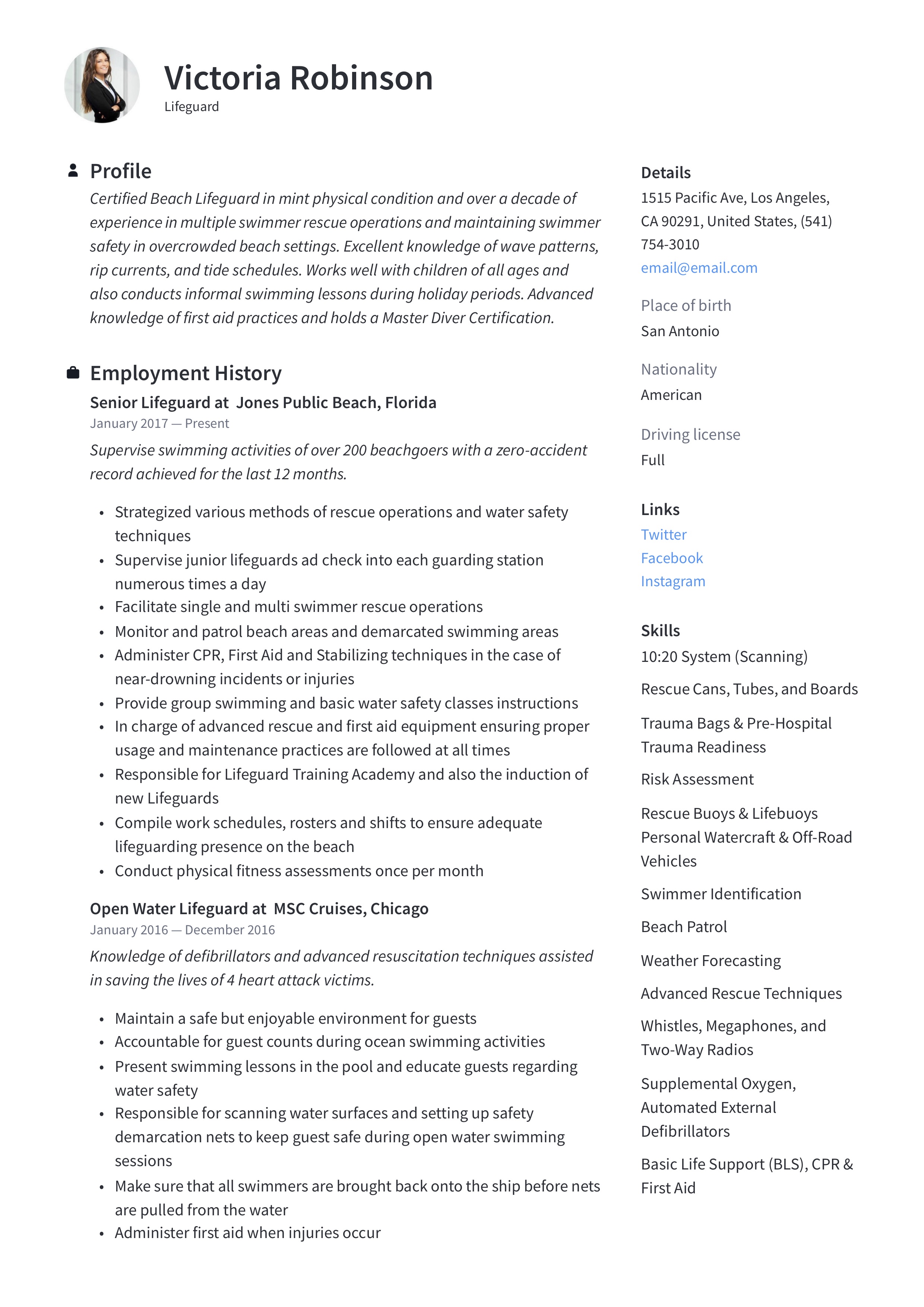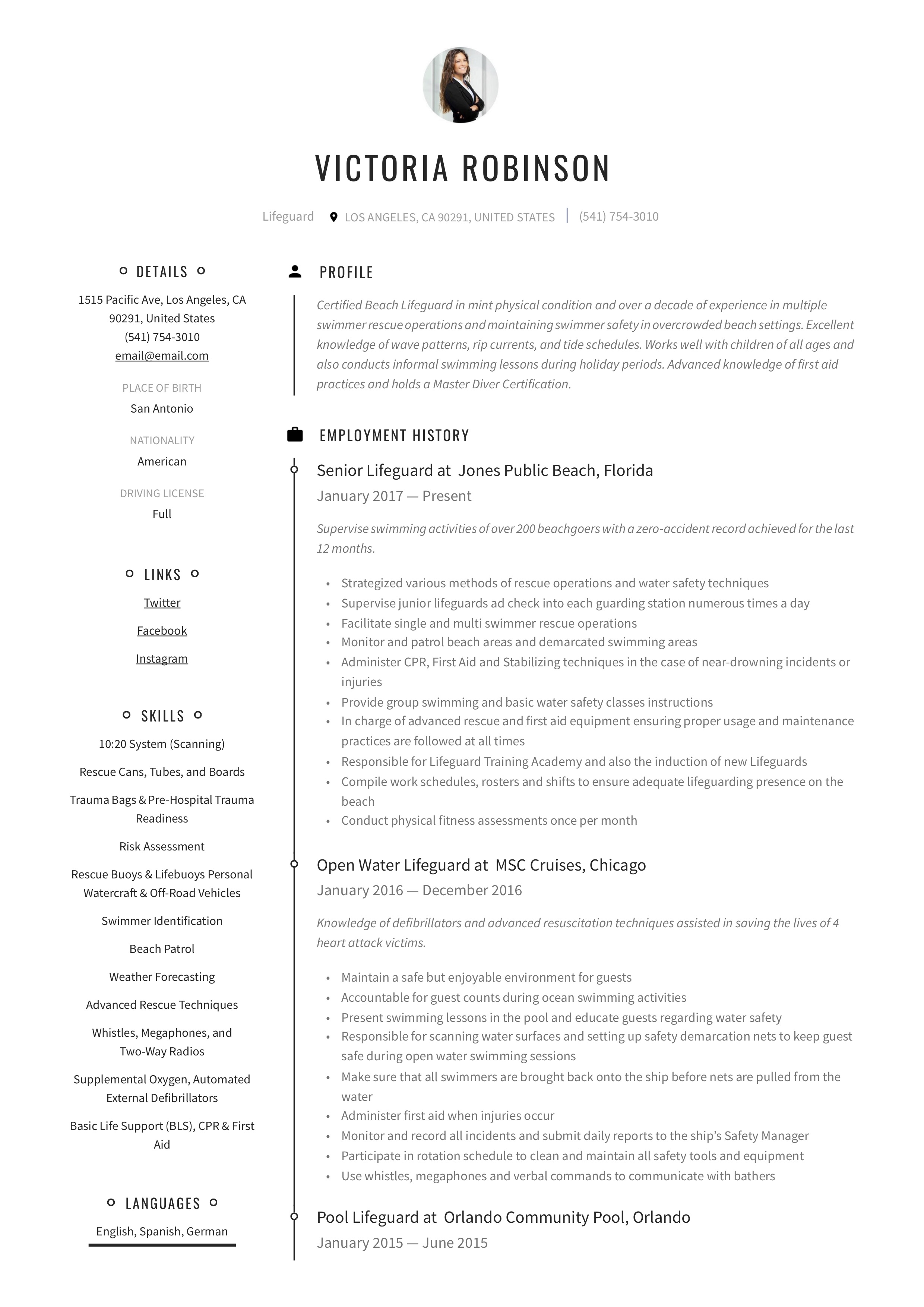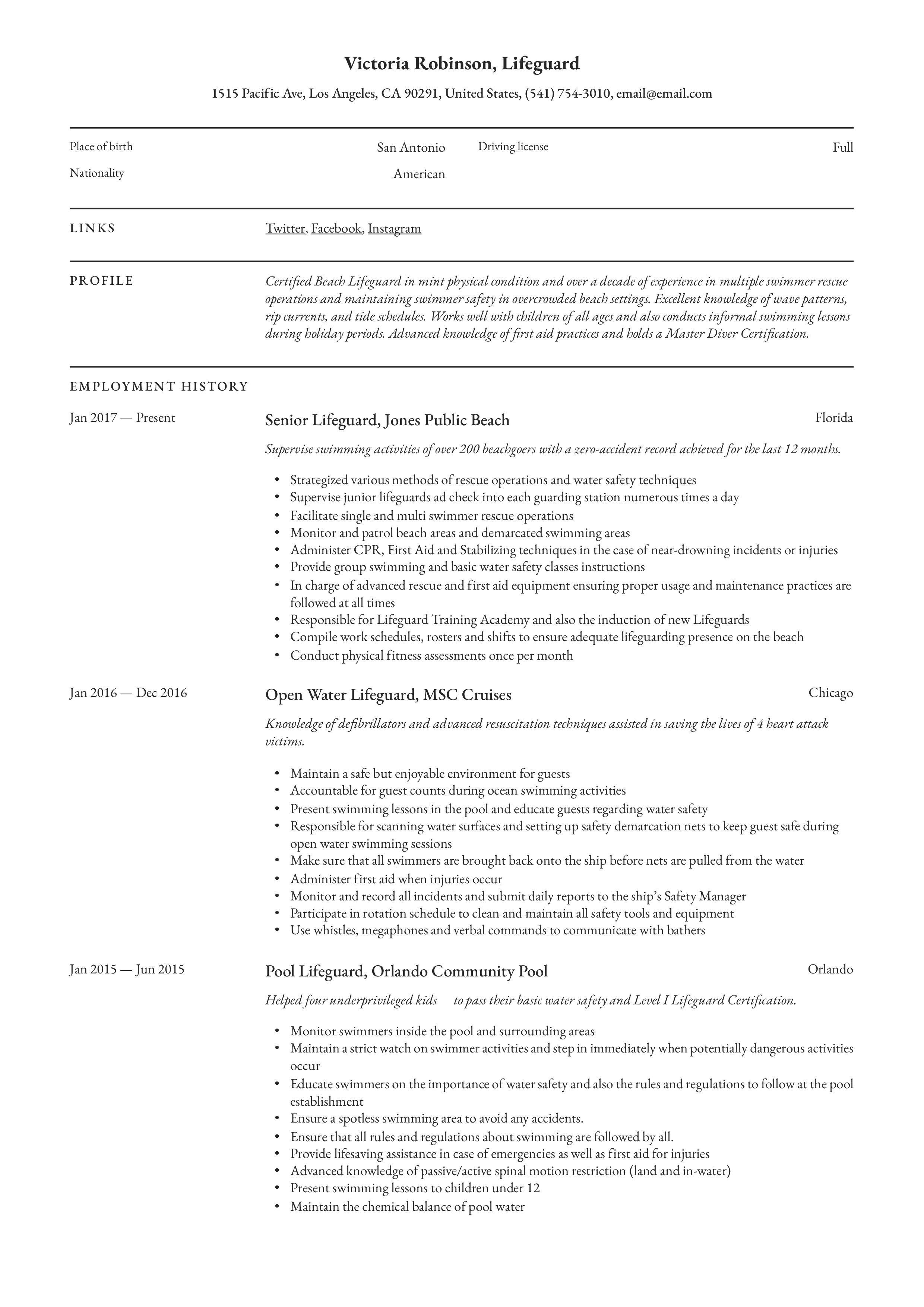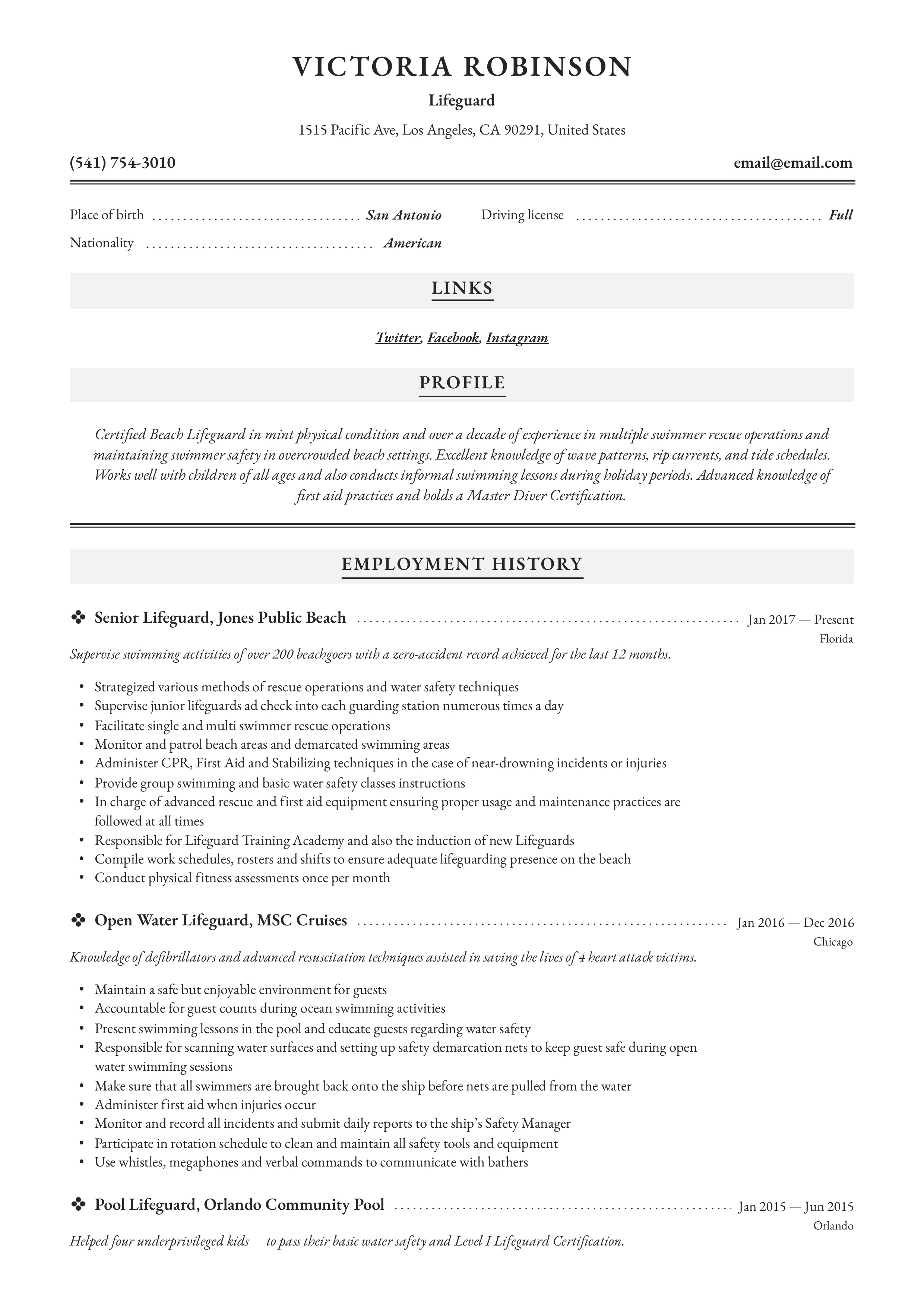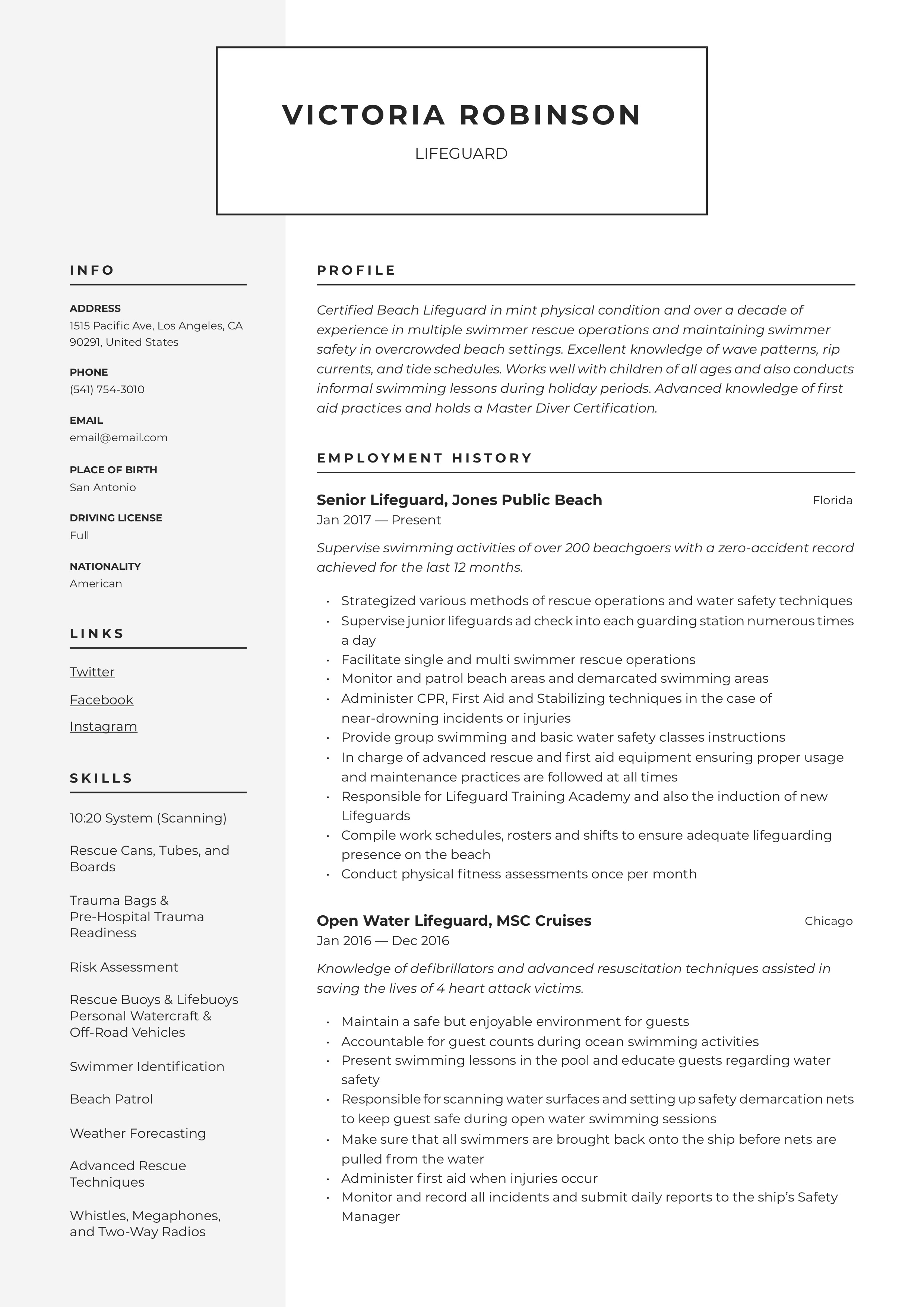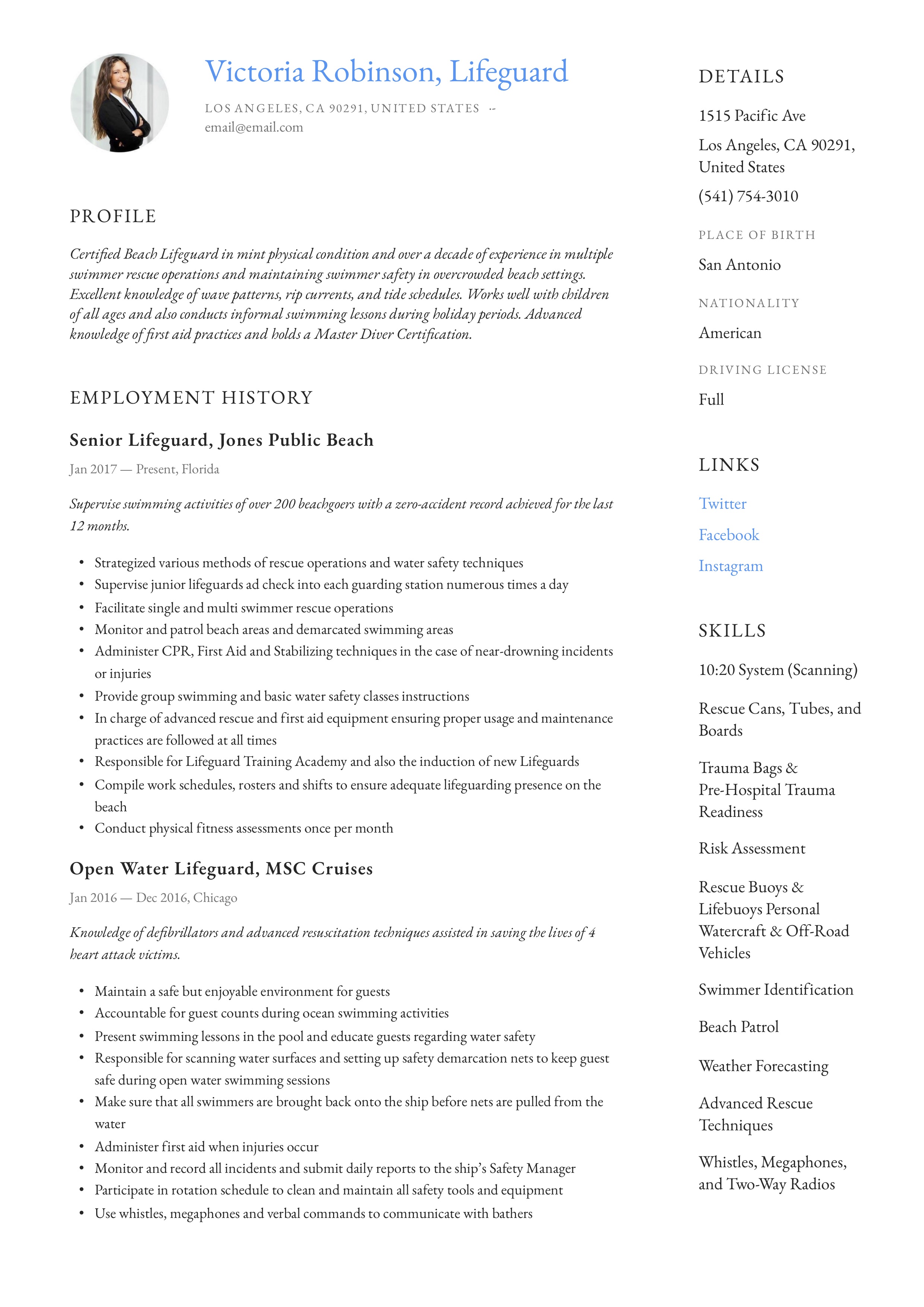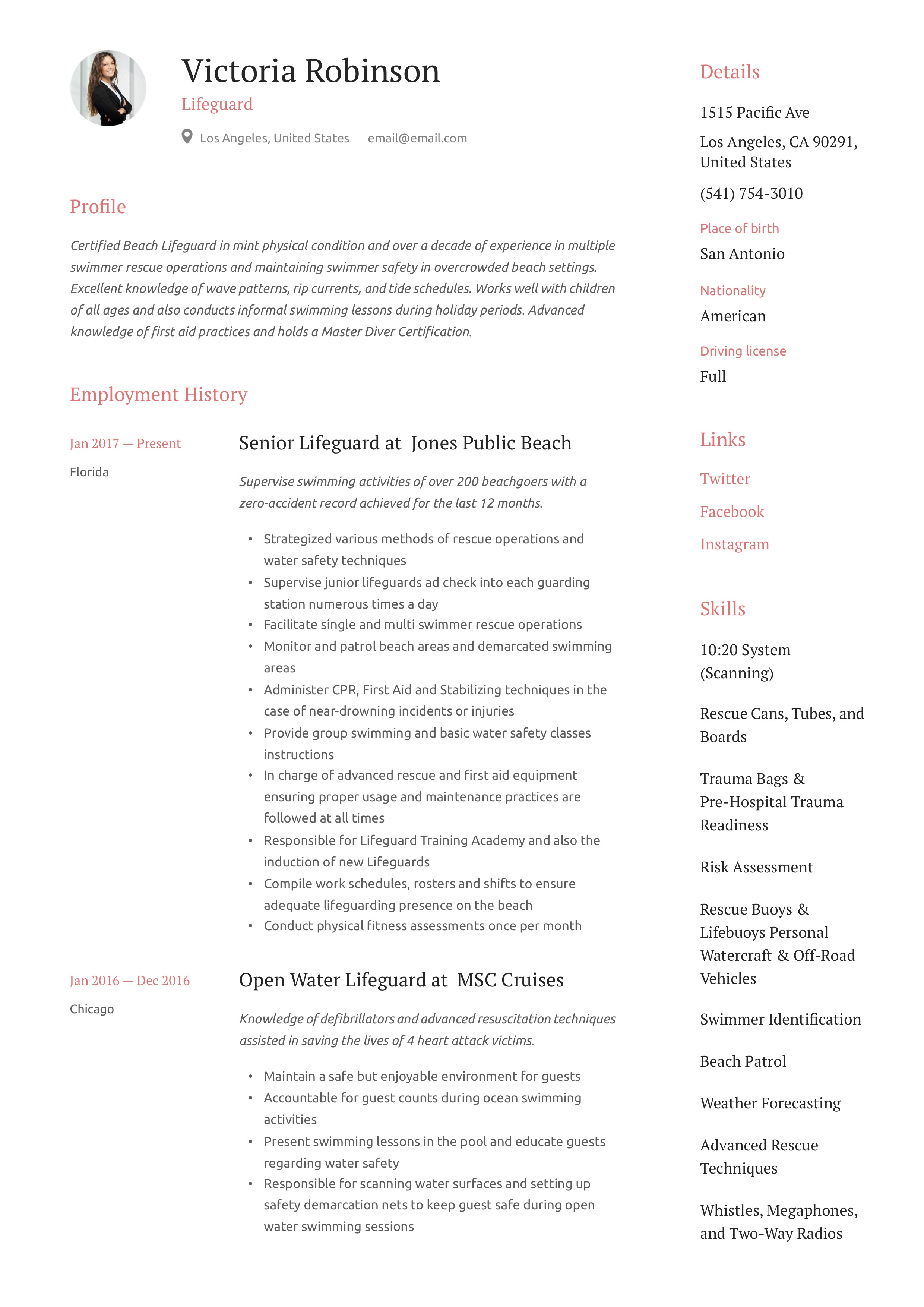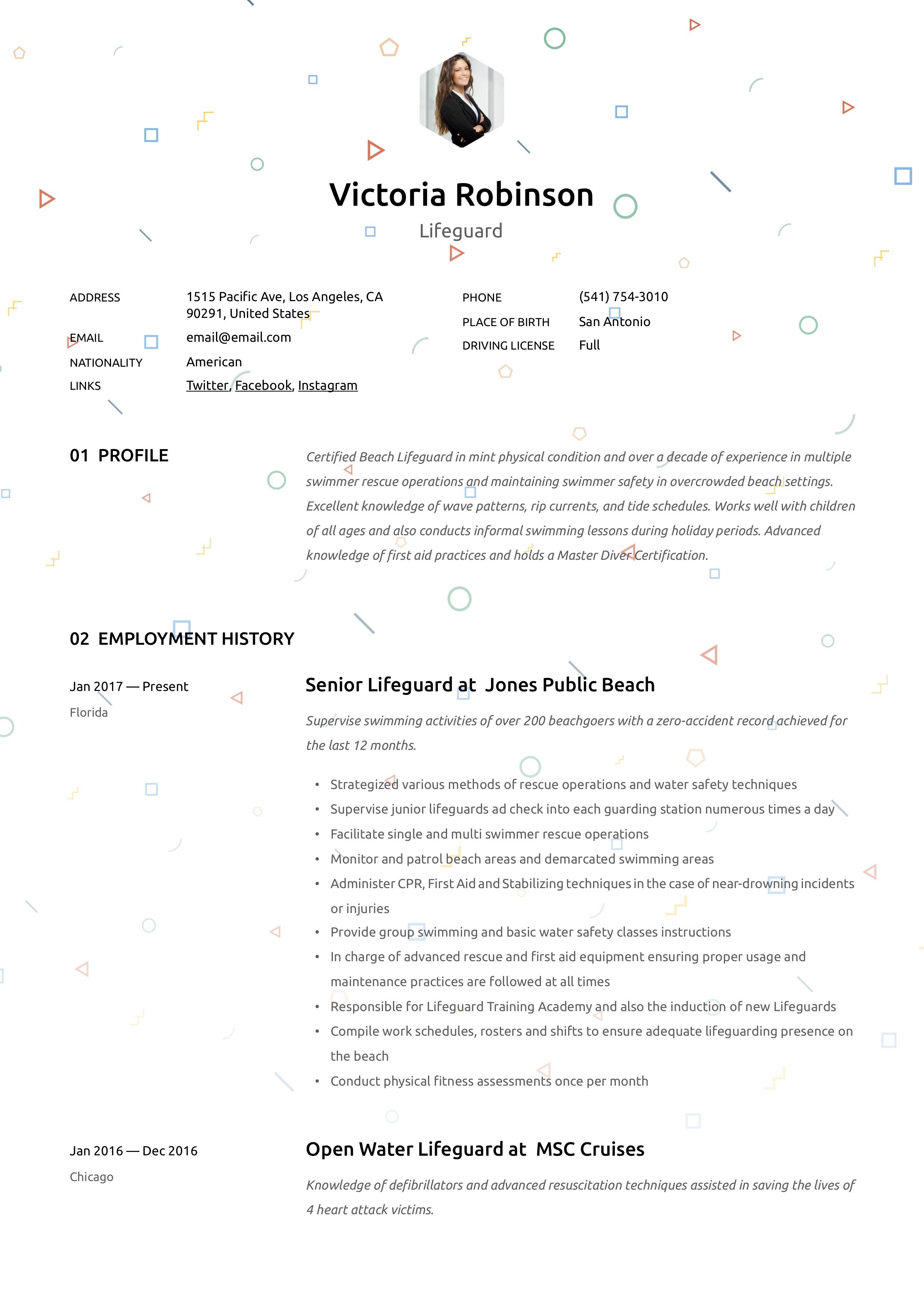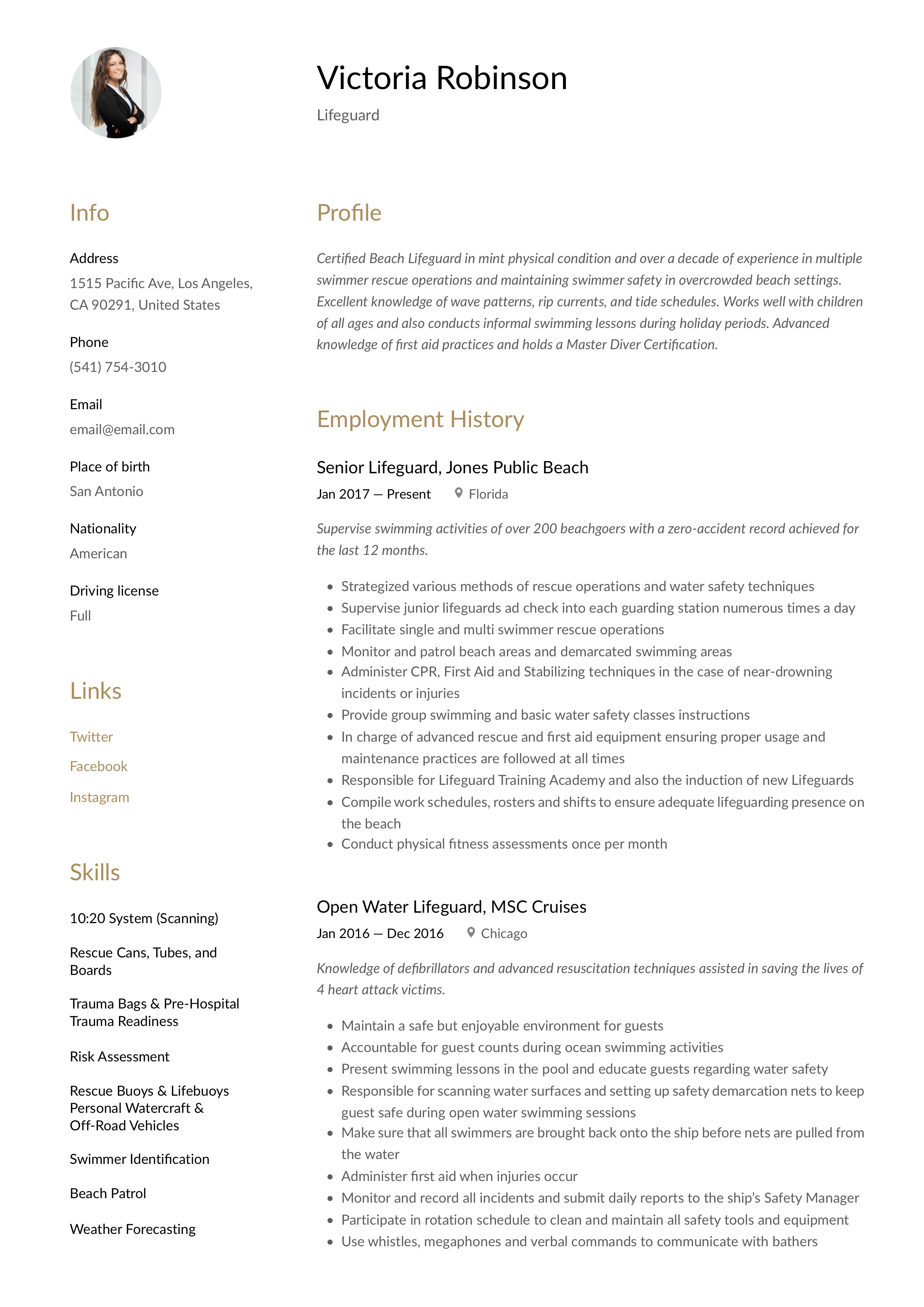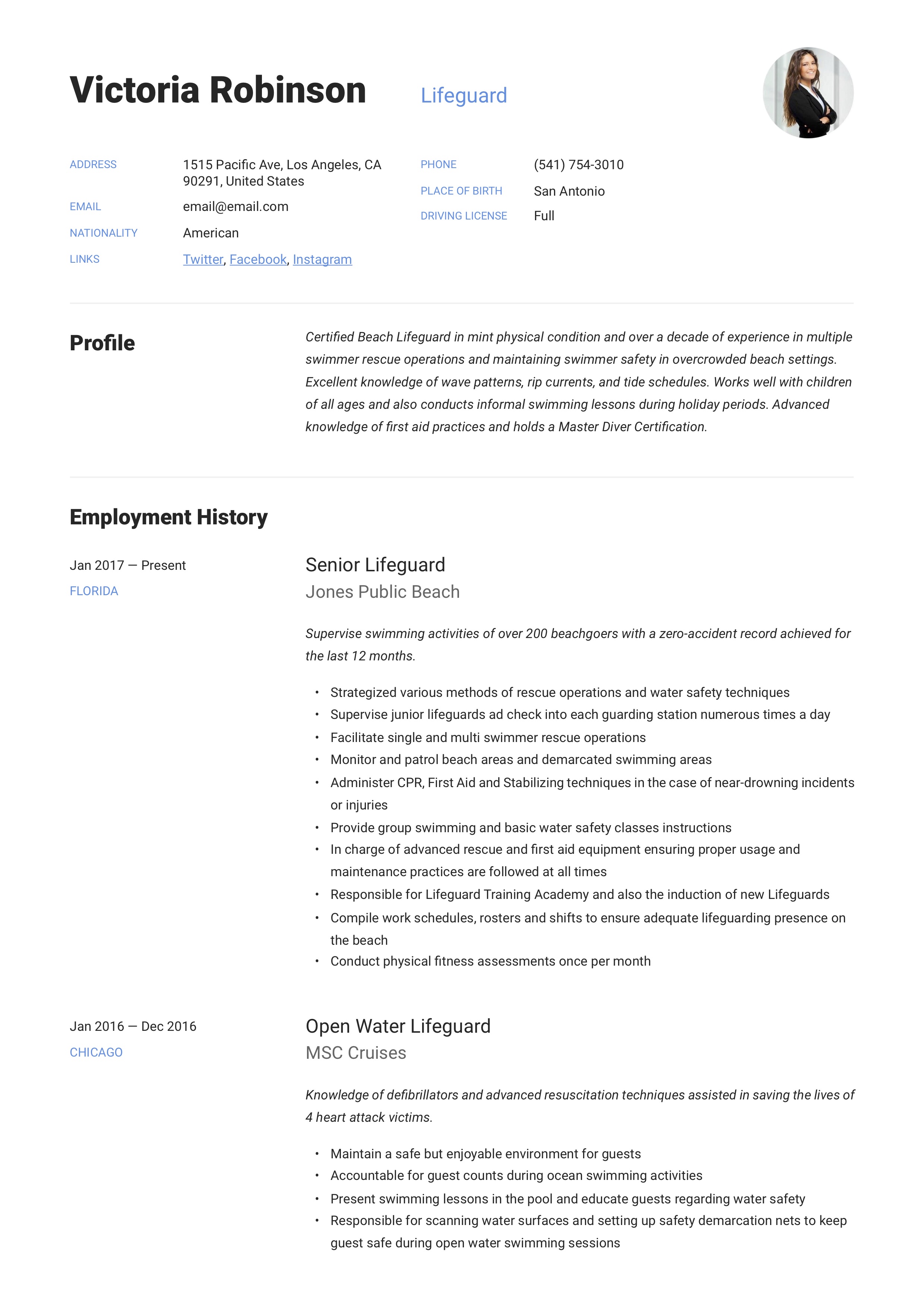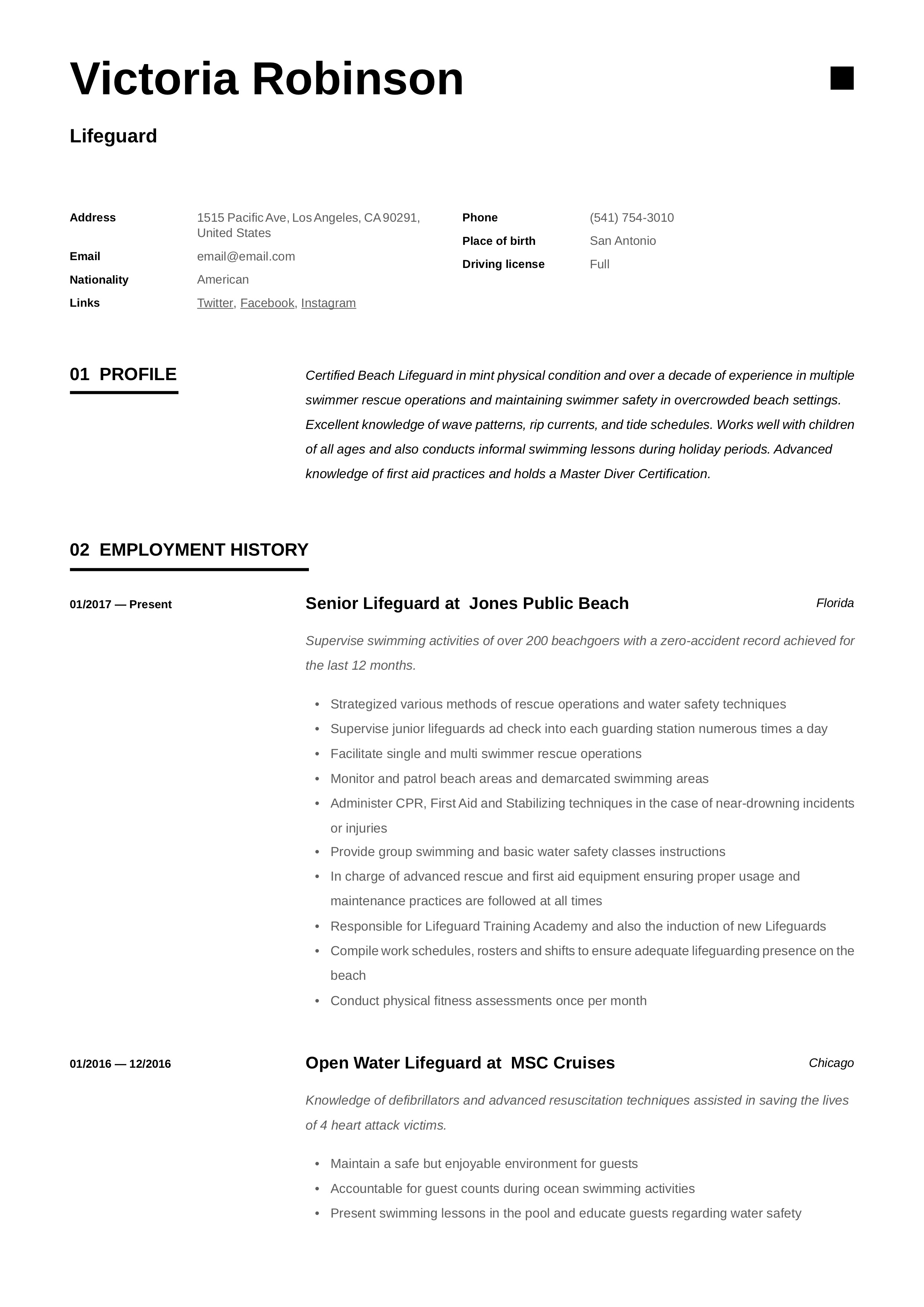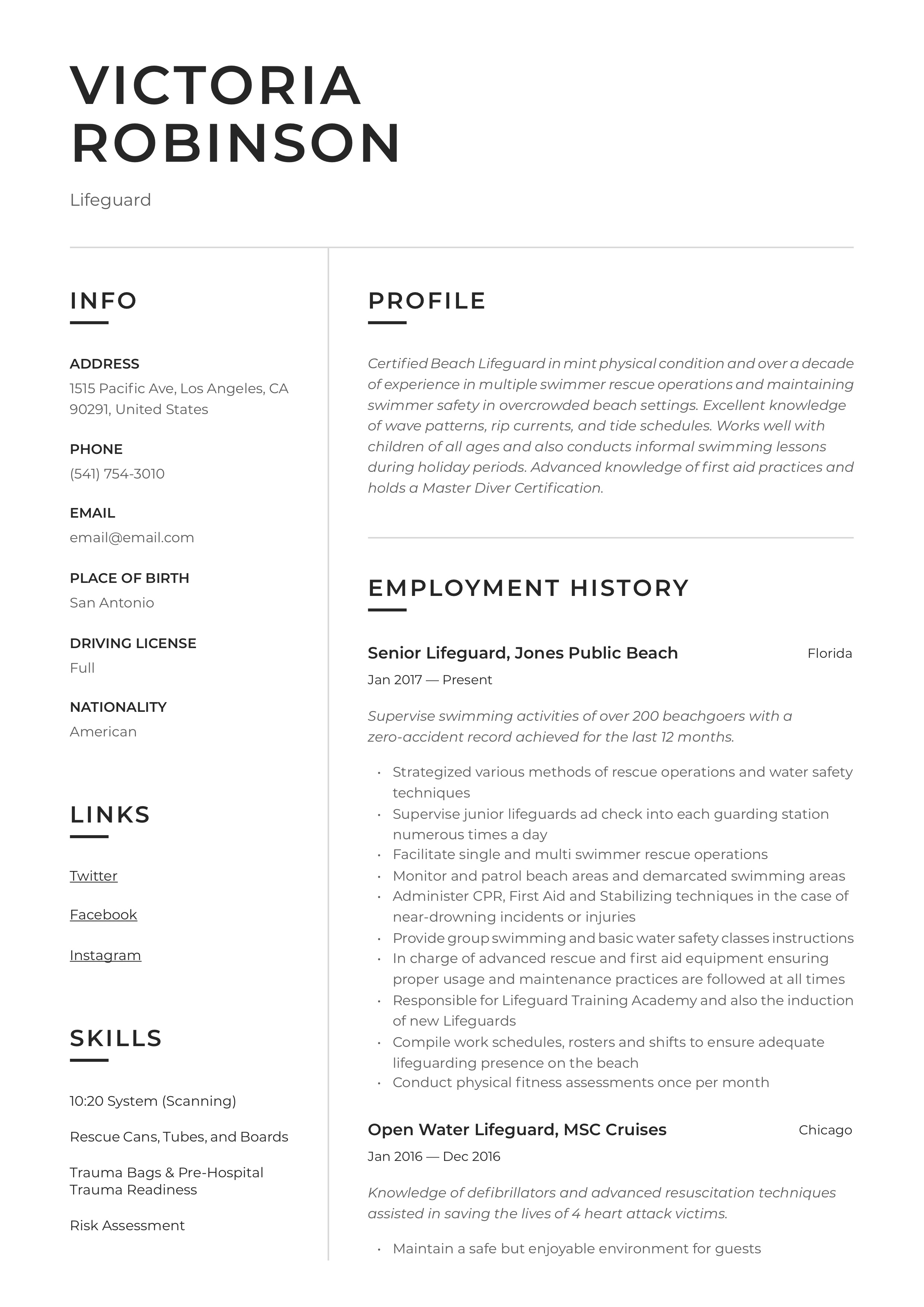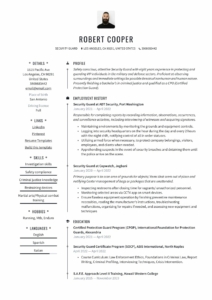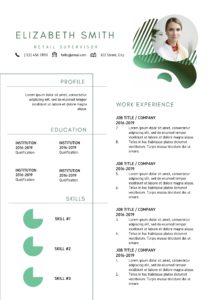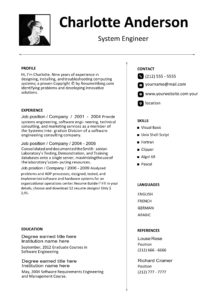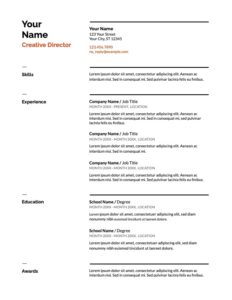Looking for a job as a Lifeguard? As you might know, it's crucial to not overlook a section in trouble on your resume! Jokes apart, we made a resume writing guide for you as a soon-to-be lifeguard, with resume examples to get your base from, so you can have a flying start and jump right into crafting that perfect resume!
With and without experience
This guide is helpful for both candidates with and without experience. In case of not having experience, you can read the guide as an ideal resume objective. Take it lightly and follow its guidelines as much as possible. Often, lifeguard job descriptions do not have that high demands, and you make a fair chance as a new one to the industry. They are waiting for your application, you guarding angels!
What you can read in this article
Lifeguard Resume Examples
(Free sample downloads are at the bottom of this page)
Lifeguard Resume Writing Guide
Resume Sections
1. Contact Information:
- First Name
- Last Name
- Address
- Mobile Number
- Email Address
- Driver's license (optional)
2. Resume Summary:
Your career summary serves the purpose of attracting attention to prompt recruiters to continue scrolling through the rest of your resume. This one paragraph can make or break your application, so make it count.
3. Qualifications Summary:
Lifeguards can find jobs with or without formal qualifications like diplomas and degrees. With some position, you do not even need a high school diploma. As with most jobs, the more qualifications you have, the better your options in terms of pay scales.
4. Relevant Lifeguard Experience:
Present your employment history from front to back and also provide details about on-the-job training which is offered in most Lifeguard roles. Lifeguards usually start their jobs when still in high school or university. Therefore, remember to add all your summer lifeguarding gigs or holiday working stints with the correct dates and months of employment. Stick to concise but informative job duties and use bullet points to neaten up the format of your resume.
5. Skills Summary/Key Skills:
The skills section is the area that most recruiters will probably look at first. In a lifeguard position, you need to display a combination of soft skills, hards skills, and also physical adeptness. Apart from listing your skills in a section of their own, you can also weave them through the rest of your resume content such as your resume summary and accomplishment sections. This strategy will increase the credibility of your application.
6. Licenses/Certifications/Relevant Coursework/Training:
Lifeguards are there to protect and save lives and to accomplish that one requires licenses, accreditations, and certifications. Lifeguards also need to keep their skills current by attending refresher courses and training programs.
No Experience:
Yes, we know that many of you are new to lifeguarding. ()The world welcomes you to have them in your care and protection).
If the job description has basic requirements or on-the-job training, for example, then take the following section lightly. A resume is about past experiences. Where an interview is about showing your motivation, personality and supporting your mentioned skills, which is where your value will be. An interview is focussed on the future. In reality, many lifeguard positions will be filled with youth and/or less experienced candidates.
What to Highlight in a Lifeguard Resume (Experienced)
Regardless of your experience as a Lifeguard, recruiters, and employers are interested in more than you being a strong swimmer or in peak physical condition.
Firstly, you need to mention the type of environmental setting you have exposure to in terms of your (possible) relevant working experience:
- Beach:
A Lifeguard role is typically associated with a beach environment, and being a lifeguard on a public or private beach is considered the most challenging of all lifeguarding jobs. You need to understand how environmental factors such as weather, tides, currents, and waves could pose a risk to bathers and provide examples in your resume of the proactive measures you would take to keep them safe. Also falling under this category is lifeguarding at ocean lagoons or tidal pools, which also pose their own unique hazards.
- Inland Water bodies:
Here we think of dams, rivers, lakes, and ponds where swimmers may flock. In these roles, Lifeguards can look after swimmers in non-surf, open-water areas situated in resorts, public parks, and campgrounds. You may not have to contend with waves and currents, but rivers can pose a serious threat to bathers when flooding occurs or if underwater caves exist beyond those murky waters. Being a lifeguard is all about identifying risks and acting to prevent those risks from causing an adverse situation. Provide details about your work environment and what processes you follow to protect the swimmers.
- Swimming Pools & Water Park:
Most of the Lifeguard opportunities at public swimming pools or recreational parks are open to high-school students, too. This kind of setting proves to be a great foundation to get adequately trained without the environmental risks associated with beach lifeguarding. Still, it's not without risk to bathers that apart from near-drowning could fall off a water slide, or risk serious injury by swimming to close to the wave generator machinery.
The second aspect to highlight is the certifications you have received. Even though you will list your accreditations and certifications in the education section of your resume which follows later, it is important to elaborate further on the extent of your training completed and possible workshops you attended.
Lifeguards who work at traditional pools will have to complete the Basic Lifeguarding Certification. If you want a job at an inland water location, you need to get the Waterfront Lifeguarding Certification. When applying for a job at a Resort or Leisure Park, hiring managers would like to see that you have completed a Water park Lifeguarding Course.
Next is the life-saving techniques you can perform. These include activities such as performing advanced water rescue, being familiar with CPR, knowledge of first aid measures, oxygen administration, and using automated external defibrillators. Add a bit more detail here by including information on experience in dealing with head, back, and neck injuries and the stabilizing techniques you have used before. You may also explain the types of rescues you have done in the past.
An important aspect to highlight is your physical condition. A clean bill of health from your physician should be received before you even apply for lifeguard roles. You don’t have to attach the medical certificate to your resume document, but provide the date of your physical exam, the name of your primary care physician, and the fact that you have been cleared to participate in all lifeguarding and training activities.
Fitness and endurance levels are things that recruiters and employers would pay particular attention to when reviewing your application. Be specific about your physical abilities how fast you can run 100 meters, the fact that you can swim 400 meters in 8 minutes and 50 meters in 50 seconds, if you can lift 100 pounds or more, have 20/20 vision, and excellent multi-limb coordination.
Elaborating a little bit more on the scope of training undergone will give your application the extra edge above the rest. Organizations such as the American Red Cross, the American Lifeguard Association, and the YMCA offer a variety of lifeguard certification and training courses. For example, if you have done training with the American Red Cross, you may mention that you can swim 300 yards without pausing using backstroke, freestyle, or breaststroke. Correct diving techniques are vital to lifeguard training, so be sure to explain how you are comfortable diving to a depth of 10 feet, for example. In this section also include the number of training hours you have under the belt (with the American Red Cross this may range from 30 to 37 hours depending on which certification you have finished).
A few added extras
- State the location, areas or regions you are willing to work in
- Also, mention your availability for instance only looking for a summer job wanting to work only during weekends or flexible to work morning shifts on some days during the week
- Think about the average number of bathers under your continuous surveillance such as working in a team of 3 lifeguards responsible for looking after 100 to 150 swimmers at any given time
- Indicate your knowledge regarding safety standards of the specific state you can work in regarding enforcing rules and regulations on a public beach, accident avoidance measures and also protocols to follow in case of injury and death
- Often not thought of in a lifeguard setting, but any additional languages you can speak would be to your advantages especially if you are stationed at a beach with a significant number of foreign tourists
Lifeguard Resume Summary and Objectives
A career summary should consist of one paragraph that takes no more than 20 seconds to read.
Fitness centers, recreational facilities, resorts, and governmental services agencies use applicant tracking systems (ATS) to screen through the waves of resumes they receive daily and match the keywords from the job description to those in the resumes. No match, no shortlist.
To beat these ‘’bots’’ and guarantee that your resume comes under review by a human eye, you need to use the terms and phrases of the job advertisement in your resume, specifically the career summary.
This is referred to as resume SEO. Use these as SEO for your career summary (or objective), to highlight technical ability, soft skills, years of working experience, and qualifications. The more your resume resonates with the job description of keywords, the better fit you will seem.
Examples:
Career Summary 1
Certified Resort Lifeguard with five years of full-time experience in supervising and ensuring the safety of bathers with excellent knowledge of rescue techniques, executing CPR, and administering First Aid. Expertise includes pool chemical composition and utilizing advanced pool cleaning equipment. Holds an accident free record and received Lifeguard of the Year award for four consecutive holiday seasons.
Career Objectives 2
Junior Open Water Lifeguard with two years of experience in maintaining swimmer safety aboard cruise ships. Passed lifeguard examination with honors and is currently completing the Paramedic Programme through the American Red Cross. Adept at using defibrillators, administering CPR, and perform advanced stabilizing techniques in cases of head, neck, and back injuries.
Career Summary 3
Certified Beach Lifeguard in the mint physical condition and over a decade of experience in multiple swimmer rescue operations and maintaining swimmer safety in overcrowded beach settings. Excellent knowledge of wave patterns, rip currents, and tide schedules. Works well with children of all ages and also conducts informal swimming lessons during holiday periods. Advanced knowledge of first aid practices and holds a Master Diver Certification.
Lifeguard Job Descriptions for your Resume
Prospective employers expect to see specific foundational skills and job activities in a Lifeguard Resume. Have a look at the example job descriptions below and use these a template to create your own unique set of duties.
Sample job descriptions:
A Lifeguard at a Municipal Pool may:
- Monitor swimmers inside the pool and surrounding areas
- Maintain a strict watch on swimmer activities and step in immediately when potentially dangerous activities occur
- Educate swimmers on the importance of water safety and also the rules and regulations to follow at the pool establishment
- Ensure a spotless swimming area to avoid any accidents.
- Ensure that all rules and regulations about swimming are followed by all.
- Provide lifesaving assistance in case of emergencies as well as first aid for injuries
- Advanced knowledge of passive/active spinal motion restriction (land and in-water)
- Present swimming lessons to children under 12
- Maintain the chemical balance of pool water
A Lifeguard at a Tidal Pool may:
- Establish a safe and secure 700 sq ft tidal pool by enforcing rules, regulations, and procedures
- Advanced knowledge of Emergency Action Plan, Front rescue, Rear rescue, Two-guard rescue Leg-wrap rescue techniques
- Provide lifeguarding duties to 200 to 300 pool patrons by identifying risky bather behavior and preventing accidents
- Keep surrounding pool areas clear of hazardous objects, and debris Maintain safety and first aid equipment appropriately by cleaning and drying them at the end of each day
- Participate in training activities to teach younger children about water safety and help junior lifeguards practice for their fitness assessments
- Conduct daily audits of the pool, surrounding areas, and safety equipment
A Junior Lifeguard in a Public Beach Environment may:
- Effectively communicate with bathers and beachgoers using whistles megaphones and hand gestures
- Competent at Victim Recognition Training (VRT), 3-D Triage scanning, 5-Minute Scanning strategies
- Conduct swift evacuation operations when adverse conditions are looming such as riptides, lightning or jellyfish brought in by the tides
- Walk around the beachfront to ensure that no alcohol or drugs are brought onto the premises
- Supervise safety measures at the beach, using 10:20 scanning and vigilance techniques
- Monitor weather reports daily to ensure the safety of beach patrons and tourists closely to ensure the safety of vacationers and swimmers.
A Senior Lifeguard in a Blue Flag Beach setting may:
- Strategized various methods of rescue operations and water safety techniques
- Supervise junior lifeguards ad check into each guarding station numerous times a day
- Facilitate single and multi swimmer rescue operations
- Monitor and patrol beach areas and demarcated swimming areas
- Administer CPR, First Aid and Stabilizing techniques in the case of near-drowning incidents or injuries
- Provide group swimming and basic water safety classes instructions
- In charge of advanced rescue and first aid equipment ensuring proper usage and maintenance practices are followed at all times
- Responsible for Lifeguard Training Academy and also the induction of new Lifeguards
- Compile work schedules, rosters and shifts to ensure adequate lifeguarding presence on the beach
- Conduct physical fitness assessments once per month
A Lifeguard on a Cruise Ship may:
- Maintain a safe but enjoyable environment for guests
- Accountable for guest counts during ocean swimming activities
- Present swimming lessons in the pool and educate guests regarding water safety
- Responsible for scanning water surfaces and setting up safety demarcation nets to keep guests safe during open water swimming sessions
- Make sure that all swimmers are brought back onto the ship before nets are pulled from the water
- Administer first aid when injuries occur
- Monitor and record all incidents and submit daily reports to the ship’s Safety Manager
- Participate in rotation schedule to clean and maintain all safety tools and equipment
- Use whistles, megaphones and verbal commands to communicate with bathers
Highlight Your Accomplishments
In this section think of achievements, awards, perhaps a rescue event you are most proud of or a special contribution you have made that assisted in swimmer safety or positively impacted on their experience at the beach.
Accomplishment statements could lose their impact if not ‘’backed up’’ by numerical values, timelines, frequencies, ranking, and scores. This is also referred to resume quantification, where you provide proof of your expertise and knowledge in lifeguarding.
When writing your accomplishment, you should be answering questions such as, What, When, Where, How often, How much or How many. For instance:
- What score did you achieve in the fitness examination?
- How long has your zero-accident score lasted?
- How often did you execute multi swimmer rescue activities?
- What is the pool size diameters that you are responsible for?
- Which advanced rescue and resuscitation equipment are you familiar with?
- How many beach patrons do you supervise on an average day?
Examples of Lifeguard accomplishment statements
- Awarded the 2019 ”Lifesaving Award for Professional Responders” from the American Red Cross
- Instrumental in 10 multi-swimmer rescue operations during the summer holiday period
- Supervise swimming activities of over 200 beachgoers with a zero-accident record achieved for the last 12 months
- Knowledge of defibrillators and advanced resuscitation techniques assisted in saving the lives of 4 heart attack victims
- Helped four underprivileged kids to pass their basic water safety and Level I Lifeguard Certification
Lifeguard Education Section Example
Lifeguards can secure full time and part-time roles without having completed any formal education. However, the more accreditations and certifications you have, the better your chances of obtaining higher paid jobs. You may also include details about exams and assessments completed during your lifeguard career.
List all qualifications, accreditations, and certifications starting with dates of completion, then descriptive name, institution, location, and state. List your high school diploma details similarly, but only include this when you have less than five years of working experience.
Here are some examples of a Lifeguard Resume in terms of education:
2019 – Bachelor of Science in Sports Medicine, Long Island University, Brooklyn, NY
Expected Graduation: 2021
2018 – Head Lifeguard Accreditation, Starfish Aquatics Institute, Miami, FL
Accumulated 650 supervisory water hours
2017 – Completed Fitness Assessment, National Aquatic Safety Company, (NASCO), Dickinson, TX
2017 Red Cross CPR and AED First Aid Certification, Maclean, VA
2016 – Advanced First Aid Diploma, National CPR Foundation, Miami, FL
2016 – Advanced Life Saving Techniques, United States Lifesaving Association (USLA), Huntington Beach, CA
2015 – Lifeguarding and Water Safety Certification, American Red Cross, Orlando, FL
Lifeguard Resume Skills
Prospective employers may have different requirements listed on the job advertisement, but technical skills, physical traits, and interpersonal skills are standardized for lifeguards because of stringent safety standards (you are after all ‘’guarding lives’’). Insert a skills' matrix into your resume, instead of presenting your key skills and attributes in a long list of bulleted points. Use a three-by-ten tables and dedicate a column to physical traits, one to technical skills and one to personality attributes, also called soft skills.
| Physical Skills | Technical Skills | Soft Skills |
|---|---|---|
| Manual Dexterity | 10:20 System (Scanning) | Punctual |
| 20/20 Vision | Rescue Cans, Tubes, and Boards | Trustworthy |
| Hand/Eye Coordination | Trauma Bags & Pre-Hospital Trauma Readiness | Communication |
| Multi-Limb Coordination | Risk Assessment | Detail Orientated |
| Endurance | Rescue Buoys & Lifebuoys Personal Watercraft & Off-Road Vehicles | Team Player |
| Manlift or personnel lift to 150 lbs | Swimmer Identification (Normal, Passive Drowning, Active Drowning, Distressed) | Energetic |
| Nimble | Beach Patrol (Inland Water & Ocean Beach) | Quick-Thinking & Decision Making |
| Depth Perception | Scanning & Vigilance Techniques | Determined |
| Peripheral Vision | Weather Forecasting | High-Risk Behavior Identification |
| Swim 400 meters in 7 minutes | Flares, Whistles, Megaphones, and Two-Way Radios | Leadership |
| Run an 8-minute mile | Supplemental Oxygen, Automated external defibrillators | Stress Tolerant |
| Cleared Medical Record | Basic Life Support (BLS), CPR & First Aid | Situational Awareness |
Qualifications/Certifications associated with Lifeguards
| Waterfront Lifeguard | Lifeguard Training Course | CPR Professional Rescuers and Health Care Providers |
| Waterpark Lifeguard | Shallow Water Lifeguard | Surf Lifeguard |
| Infant CPR Training | Personal Rescue Watercraft certification | Aquatic Rescue Response Team certification |
| Emergency Oxygen Administration | In- AED Certified | Bachelor's Degree in Physical Education |
Action Verbs for your Lifeguard Resume
| Coordinating | Scheduling | Monitoring |
| Controlling | Problem Solving | Scanning |
| Tracking | Moving | Detecting |
| Organizing | Lifting | Rescuing |
| Spotting | Checking | Allocating |
| Swimming | Placing | Stabilizing |
| Handling | Carrying | Identifying |
| Supervising | Removing | Hoisting |
Lifeguard Interview Advice, especially if you have no lifeguard experience yet.
Many lifeguards-to-be are new to the job. Hear some tips of what you can expect from an interview. Espcially, if you have no experience as a lifeguard yet. Good luck getting that job!
Professional Information on Lifeguards
Sectors: Tourism, Recreation, Fitness, Leisure, Training, Aquatics
Career Type: Training, Supervisory, Servicing, Rescue
Person type: Supervisor, Rescuer, Responder, Safety Professional, Trainer
Education levels: Post School Diplomas, Accreditations, Certifications, Licenses, Associate Degrees
Salary indication: $27,456 and $37,651 per annum / $7 – $22 per hour
Labor market: 9% growth from 2016 – 2016 (BLS)
Organizations: Municipal Pools, Ocean Beaches, Campgrounds with dames and lakes, Hotels, Resorts, Waterparks, Cruise Ships, Recreational Facilities, Fitness Facilities, Outdoor Events
Download Lifeguard Resume Examples
